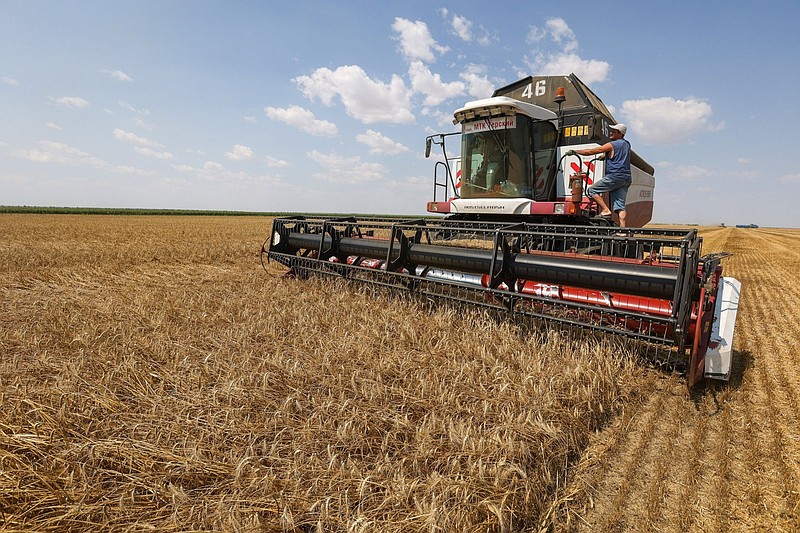A few months into the war in Ukraine, appetite for Russian wheat remains strong and there's little sign that exports will fall soon.
After briefly dropping at the start of the war as some traders were impacted by financing and logistics issues, the country's wheat shipments have remained in line with usual volumes. While it's becoming harder to trade grain from there, Russian companies and international merchants like Viterra continue to sell large amounts.
Many foreign firms have left Russia, but a global willingness to keep buying and selling its crops underscores the need for grain especially with food prices hitting a record after the invasion slashed Ukraine's grain exports. To highlight the strong demand, data provider Logistic OS estimates Russia's April wheat sales tripled from a year earlier, albeit up from a lower-than-usual amount due to export taxes at the time.
Viterra was the third-biggest shipper in April, after Russian exporters Trading House RIF and Aston, according to Logistic OS data. Global trading giants Cargill Inc. and Louis Dreyfus Co. also exported some wheat, and international companies haven't drastically altered volumes since the invasion.
Overseas agribusinesses have largely stayed in Russia since the start of the war, although some said they won't make new investments there. They've seen their share of Russian wheat exports steadily fall to state-controlled companies in recent years as the government expands its role in an increasingly strategic sector.
As part of Russia's push to expand, state-owned lender VTB Group has bought port terminals and operations in the country, and backed local grain traders.
Even with high freight and insurance costs, Russian grain has kept flowing because the sector hasn't been sanctioned or faced as much pressure to curb business there as in other industries. Plus, reducing supplies from the wheat giant risks worsening global hunger. Wheat prices hit a record in March on concerns about a global shortage.
"There is high demand for wheat because of general concerns about next season and weather problems in different parts of the world," said Dmitry Rylko, general director of Moscow-based Institute for Agricultural Market Studies.
Russia traditionally has warmer ties with many Middle East and North African countries, which are among the most reliant on its wheat.
In oil, producers like BP are abandoning stakes in investments related to Russia, and some major trading houses will stop dealing the country's crude. The U.S. has banned Russian oil, and the European Union wants to do the same, while the bloc is also moving to cut its reliance on Russian gas.
International grain traders have a raft of assets in Russia. Viterra jointly owns the Taman grain terminal on the Black Sea with VTB, and Louis Dreyfus has a terminal on the Sea of Azov. Archer-Daniels-Midland Co. and Cargill also have a presence, though Bunge Ltd. in March sold its Rostov grain terminal.
A Viterra spokesperson confirmed that it suspended new development and expansion projects in Russia, but didn't comment on whether it would curb trading. Cargill referred to a previous statement that it stopped investments but would keep operating food and feed facilities. ADM said it has curbed Russian operations that aren't related to essential food commodities and is sourcing from other regions where possible. Bunge reiterated that it stopped all investments and nonessential activities in the country since March 25, with current operations limited to support domestic farmers and consumers by producing staple foods at their single crush facility.
Louis Dreyfus declined to comment.
Before the war, Russia's wheat shipments were down roughly 24% from a year earlier amid a smaller crop and export curbs. They were running at a similar pace with sales of 26.8 million tons by late March, when customs data was last published. April's exports totaled 2.1 million tons, according to Logistic OS.
As well as benefiting from strong demand for grain -- driven further by a war that Russia started -- the government's wheat revenue has been bolstered by an export tax it introduced to safeguard local supplies. The duty is linked to wheat prices.
For recent shipments, some traders may be using up their allowances allocated under an export quota that was also implemented to protect the domestic market. Plus, some of the sales may have been booked before the war.
Russia's May shipments may ease a bit to roughly 1.7 million tons, according to IKAR's Rylko. The big question is whether Russia will export usual amounts in the new season that starts in July.
"I would suspect that the international traders will try to keep business going, because Russia will be the biggest source of wheat in the world," Rylko said.
Information for this article was contributed by Archie Hunter and Tarso Veloso Ribeiro of Bloomberg News.
